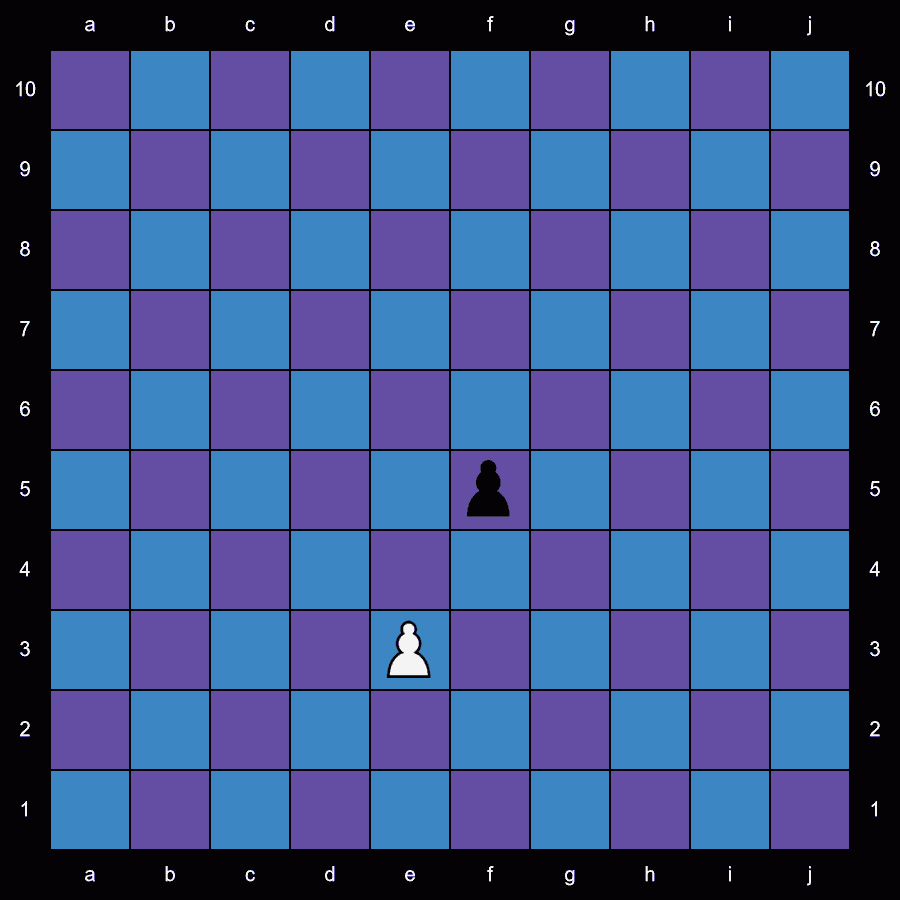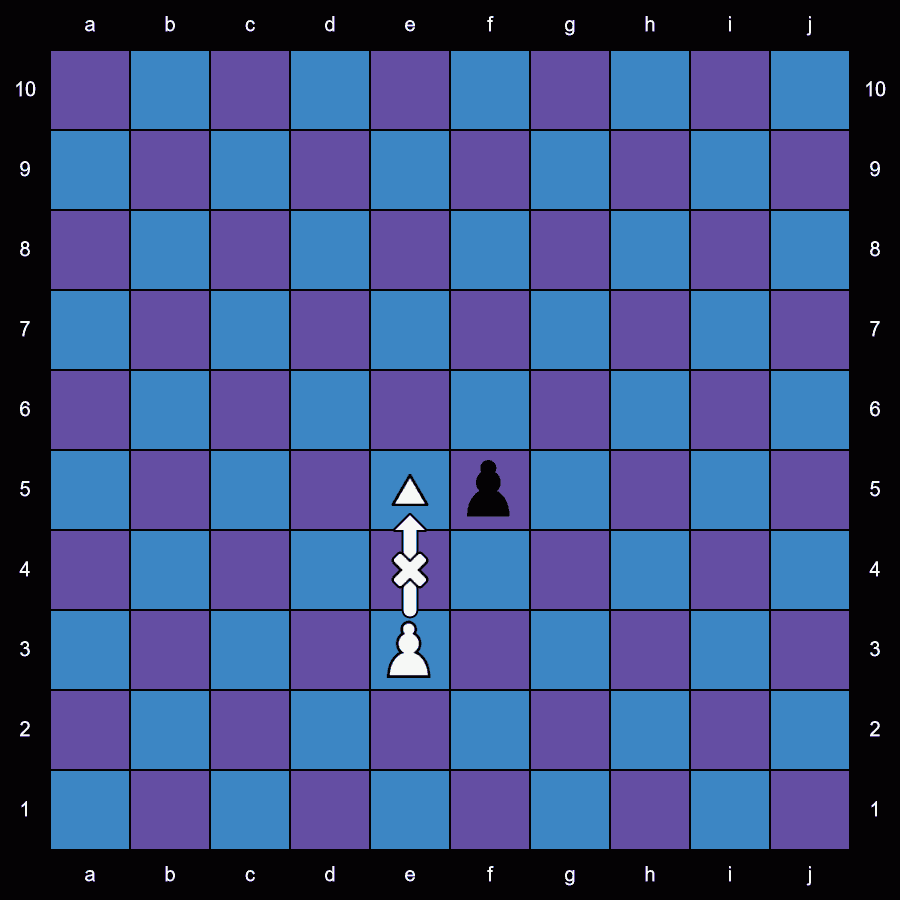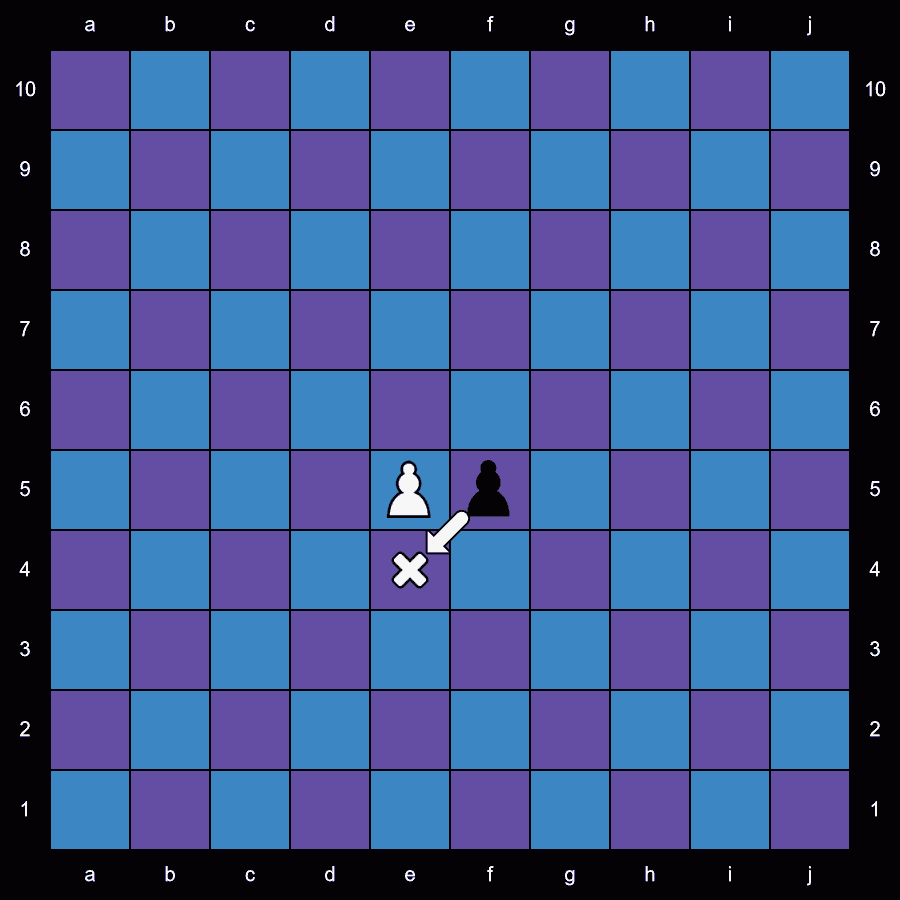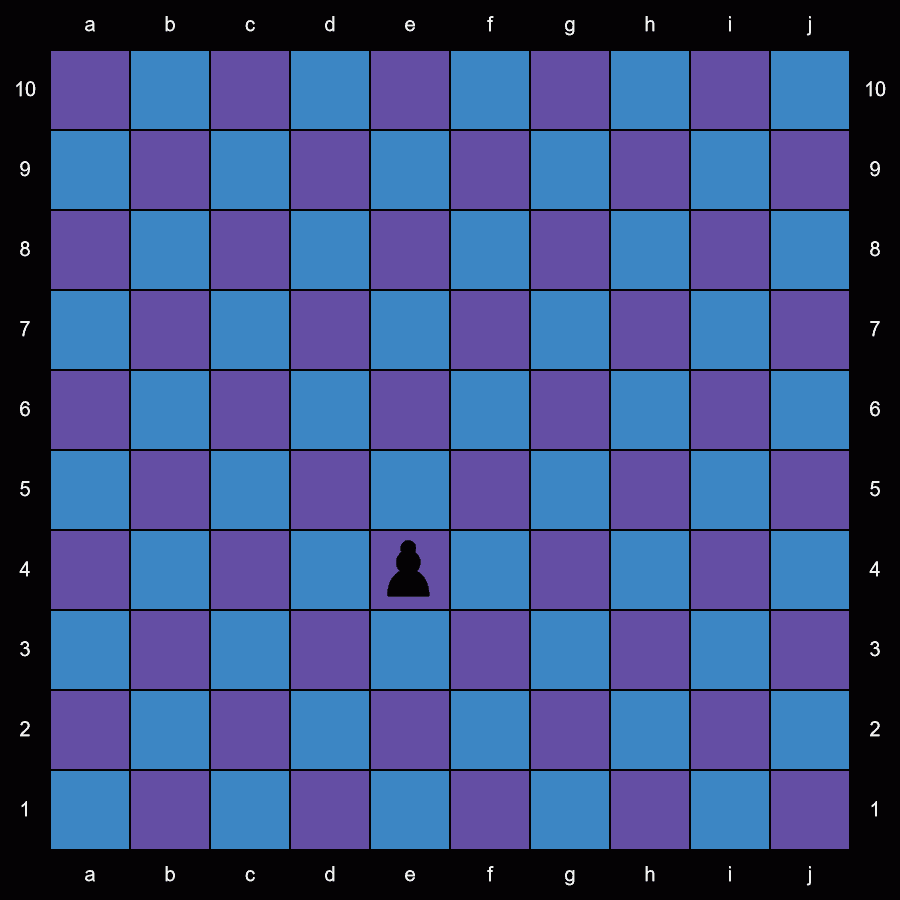ArchMage Chess
ArchMage Chess
Designed by Cyrus Arturas
| Introduction
Setup Pieces Play on Game Courier Contact |
Introduction
There have been many variations of chess rules throughout history. One of the earliest known variations of chess from the 6th century CE is called Chaturanga from India. Chaturanga is the predecessor for the modern form of European Chess most played today in the West and internationally throughout the world. If you wish to learn more about historical ancient chess variations and their rules please visit AncientChess.com which is a great resource of information and research by Rick Knowlton.
The unit symbols and diagrams for ArchMage Chess were made using the Chess Board Painter Tool on MusketeerChess.net. Musketeer Chess is a unique variant of chess created by Zied Haddad which provides fairy pieces for sale on their website. The creation of ArchMage Chess was inspired from studying different chess variations on ChessVariants.com especially Terachess II and its predecessors designed by Jean-Louis Cazaux who is the author of A World of Chess.
Another interesting chess variant I’ve come across is called 3D-GrandChess designed by Tarcisio Barison which is played in an 8x8x8 Space, equivalent to 512 Cubic Boxes and each player commands an army of 128 GrandPieces.
Other popular chess variants include Shatranj (Persian Chess), Makruk (Thai Chess),Shogi (Japanese Chess), Xiangqi (Chinese Chess), Janggi (Korean Chess), Amazon Chess, Courier Chess, Omega Chess, Metamachy, Capablanca Chess, Gothic Chess, and Chaturaji (Indian 4 Player Chess).
If you want to contact Cyrus Arturas you can reach him by email at ArchMageChess@protonmail.com or through his profile on Chess.com.
Chess.com/member/ArchMageChess
ChessVariants.com/who/ArchMageChess
Setup
ArchMage Chess is played on a 10x10 board and has 3 rows of units in each army. Each player starts with 30 units in their army containing 14 different unique units plus 4 special units acquired thru promotion and 2 special units acquired thru summoning. The unique units seen in chess variants are called fairy pieces.
Front Row : Pawn (10)
Mid Row : Griffon (2), Bishop (2), Minotaur (2), Jester (2), Princess (1), Prince (1)
Back Row : Dragon (2), Rook (2), Pegasus (2), Sorceress (1), Queen (1), King (1), Mage (1)
Initial Setup :

Pieces
Unit Moves and Captures
Pawns
Pawn : It moves 1 square forward without capturing exactly as in European Chess, including en passant capture. It may move 2 squares forward without capturing on its first initial move from starting position. It captures 1 square diagonally forward but cannot move diagonally forward without capturing.
The Pawn is the least powerful unit in the game.
The Pawn promotes to an ArchMage when it reaches the last row.

En Passant Capture
When the rule to allow a pawn to move 2 squares on its first move was added, a pawn could potentially evade capture by an opponent's pawn by going past a square under attack. The en passant capture (from the French for “in passing”) was added to prevent this. The capture is made exactly as if the pawn had moved only one square forward. There are special conditions for the en passant capture:
-
A pawn must move 2 squares from its initial position in a single move.
-
An opposing pawn must be attacking the square the first pawn moved over.
-
The first pawn can be captured as if it moved only 1 square.
-
The capture can only be made at the opponent's next move. If the capture is not made, the first pawn is safe from en passant capture for the remainder of the game.
En Passant Capture
In the diagram below, the white pawn has not moved from its initial position. Its first move can be 1 or 2 squares ahead. The first square is under attack by the black pawn (pawns attack diagonally) as indicated by the X. The white pawn moves ahead 2 squares, avoiding the attack. On the next move, the black pawn moves into the square where the white pawn would have moved if it could only move a single square on the first move. The black pawn successfully attacks the white pawn, and captures it “en passant”. The white pawn is removed from play.




Jester
Jester : It moves 1 square in any direction orthogonally, or may jump to a position 2 squares diagonally. When moving 2 squares diagonally, it may jump and it does not matter what unit intermediate squares contain.
The Jester promotes to an ArchMage when it reaches the last row.

Sorceress
Sorceress : She moves as a King (1 sqaure in any direction). When moving 2 or 3 squares orthogonally or diagonally, she may jump and it does not matter what unit intermediate squares contain.
The Sorceress promotes to an ArchMage when she reaches the last row.

Positional Switch
The Sorceress has the ability to swap places with any ally unit except the King in a 3 square radius.


Demoness Summoning
The Sorceress may summon 1 Demoness unit on any square adjacent to herself in a 1 square radius which is not already occupied by another unit. Summoning a unit counts as 1 move on your turn therefore ending your turn. A Sorceress may only have 1 Demoness summoned per player in the game at a time. When a Demoness dies, a Sorceress may summon another one on the turn after the player’s next turn.
The Demon and Demoness need 1 turn to recharge in the astral realm after dying in the mortal realm before they may be summoned to the battlefield again.

Demoness
Demoness : She moves indefinitely to any square diagonally or 1 square orthogonally.

Mage
Mage : He moves as a King (1 square in any direction), or may jump to a position 2 squares away, jumping in any orthogonal or diagonal direction, or he can (2,1) jump as a Knight in European Chess and it does not matter what unit intermediate squares contain.
The Mage promotes to an ArchMage when he reaches the last row.

Positional Switch
The Mage has the ability to swap places with any ally unit except the King in a 3 square radius.


Demon Summoning
The Mage may summon 1 Demon unit on any square adjacent to himself in a 1 square radius which is not already occupied by another unit. Summoning a unit counts as 1 move on your turn therefore ending your turn. A Mage may only have 1 Demon summoned per player in the game at a time. When a Demon dies, a Mage may summon another one on the turn after the player’s next turn.
The Demon and Demoness need 1 turn to recharge in the astral realm after dying in the mortal realm before they may be summoned to the battlefield again.

Demon
Demon : He moves indefinitely to any square orthogonally or 1 square diagonally.

ArchMage
ArchMage : It moves as a Queen (indefinitely to any square orthogonally or diagonally) and can (2,1) jump as a Knight in European Chess. When moving 2 or 3 squares, it may jump and it does not matter what unit intermediate squares contain.
The ArchMage is the most powerful unit in the game.
The ArchMage may only be acquired through the promotion of other units.
The Mage, Sorceress, Jesters, and Pawns may all promote to an ArchMage upon reaching the last row on the opposite side of the board.

Positional Switch
The ArchMage has the ability to swap places with any ally unit except the King in a 3 square radius.


Demon Summoning
The ArchMage may summon 1 Demon unit and/or 1 Demoness unit on any square adjacent to itself in a 1 square radius which is not already occupied by another unit. Summoning a unit counts as 1 move on your turn therefore ending your turn. An ArchMage may only have 1 Demon and/or 1 Demoness summoned per player in the game at a time. When a Demon or Demoness dies, an ArchMage may summon another one on the turn after the player’s next turn.
The Demon and Demoness need 1 turn to recharge in the astral realm after dying in the mortal realm before they may be summoned to the battlefield again.

King
King : He moves 1 square in any orthogonal or diagonal direction to an unattacked square.

Check
The King is in check if it is attacked by one or several enemy pieces. When the King is in check he must move to a square that is not being attacked or the player must move a unit to block the path of the attacking unit. It is forbidden to play a move leaving one's King in check.
Checkmate
If the King is under attack and is unable to move to any adjacent square due to being blocked by other ally units, or no ally unit is available to block the attacking unit’s path, and adjacent squares are also being attacked, then the King is in checkmate and the player controlling that King loses the game. The goal of the game is to place the opposing player’s King in checkmate. The first player to checkmate the opposing player’s King is the winner.
Draw
If the King is safe on his square but adjacent squares are being attacked or are blocked by other units and the player has no legal moves left but to move their King then the King is in a stalemate and the game is a draw. Another game must be played to break the tie.
Castling
Castling uses the king and one rook, and is the only time in a game when more than one piece may be moved during a single turn. In castling a king is moved 2 squares towards the rook and the rook is then moved to the square on the other side of the king.
Castling has some rigid requirements:
-
Both the king and the rook may never have moved during the game.
-
There are no pieces between the king and the rook.
-
The king is not in check.
-
The king does not cross over a square that is attacked by the opponent's pieces.
-
The king does not end the move on a square that is attacked by the opponent's pieces. (The castling move cannot end with the king in check.)
Kingside Castling
There are two forms of castling. One is called “kingside castling”. It is also known as “short castling”, since it is performed to the short side of the board and the rook only has to move two squares to the opposite side of the king.
It is diagramed below:




Queenside Castling
The second form of castling is called “queenside castling”, where the king moves towards the square vacated by the queen. It is also known as “long castling”, since it is performed to the long side of the board and the rook has to move three squares to the opposite side of the king.
It is diagramed below:




Queen
Queen : She moves indefinitely to any square orthogonally or diagonally.

Prince
Prince : He moves and captures 1 square in any orthogonal or diagonal direction. He moves without capturing 2 squares in any orthogonal direction.
The Prince promotes to a Warrior Prince when he reaches the last row.

Warrior Prince
Warrior Prince : He moves as a King (1 square in any direction), or may jump to a position 2 squares away, jumping in any orthogonal or diagonal direction, or he can (2,1) jump as a Knight in European Chess and it does not matter what unit intermediate squares contain.

Princess
Princess : She moves as a Queen or she can (2,1) jump as a Knight in European Chess.
The Prince and Princess are slightly more powerful units than the King and Queen since they are still youthful and therefore more nimble and energetic.

Bishop
Bishop : He moves indefinitely to any square diagonally.
The Bishop promotes to an Archbishop when he reaches the last row.

Archbishop
Archbishop : He moves as a Bishop or he can (2,1) jump as a Knight in European Chess.

Rook
Rook : He moves indefinitely to any square orthogonally.
The Rook promotes to a Chancellor when he reaches the last row.

Chancellor
Chancellor : He moves as a Rook or he can (2,1) jump as a Knight in European Chess.

Minotaur
Minotaur : It moves as a King or it can (2,1) jump as a Knight in European Chess.

Pegasus
Pegasus : It can (2,1) jump as a Knight in European Chess.
It can also (3,1) jump or (3,2) jump.

Griffon
Griffon : It moves 1 square orthogonally and then slides away an indefinite number of squares diagonally. It is authorized to go only 1 square orthogonally. It cannot jump, and the unobstructed path must start with the orthogonal movement.

Dragon
Dragon : It moves 1 square diagonally and then slides away an indefinite number of squares orthogonally. It is authorized to go only 1 square diagonally. It cannot jump, and the unobstructed path must start with the diagonal movement.

 This 'user submitted' page is a collaboration between the posting user and the Chess Variant Pages. Registered contributors to the Chess Variant Pages have the ability to post their own works, subject to review and editing by the Chess Variant Pages Editorial Staff.
This 'user submitted' page is a collaboration between the posting user and the Chess Variant Pages. Registered contributors to the Chess Variant Pages have the ability to post their own works, subject to review and editing by the Chess Variant Pages Editorial Staff.
By Cyrus Arturas.
Last revised by Cyrus Arturas.
Web page created: 2022-05-03. Web page last updated: 2023-02-05

